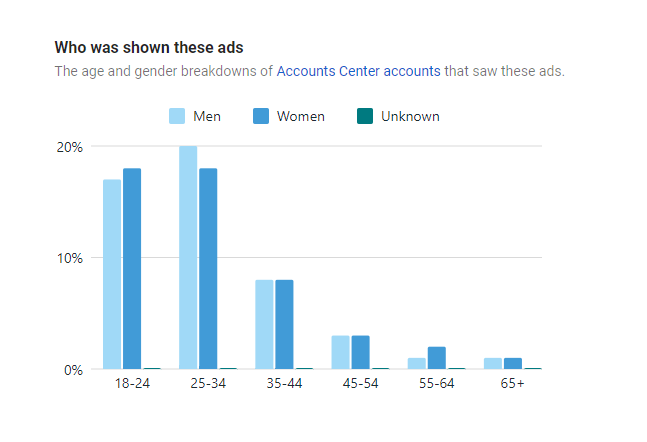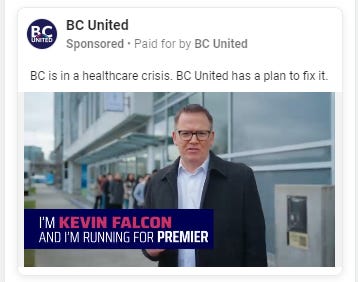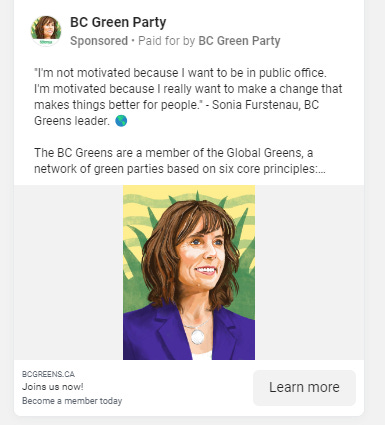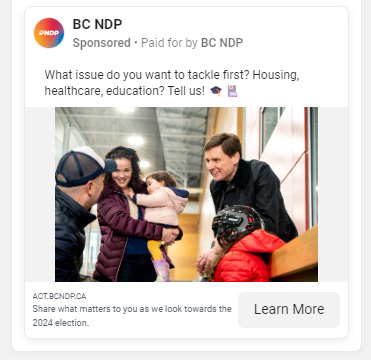As we inch closer to the election, we are going to start seeing more and more ads. Parties will try to catch your attention in whatever way they can as you scroll through your feed. Not every social media platform will be bombarded with ads — TikTok and X do not allow political advertising — but if you are on Facebook or Instagram you are sure to see a few.
Meta, the company that runs both platforms, provides tools to examine political ads. Using those, I decided to look at who is running what, and to what audience, and what that might say about their campaign strategy going into the summer. These tools are imperfect, as they limit how specifically you can search. The exact amount spent can only be searched in set blocks (the past 7, 30, or 90 days), but the ads themselves can be searched (with non-specific spending categories) as far back as someone wants to delve. I also started working on this post about a week before it goes out, so things may have changed by the time you read this.
BC Conservatives
According to the Meta Ad Library, the BC Conservatives’ page — run by 2 people — have posted around 38 different ads since the beginning of the year. In the 90 day search (Mar 19 - Jun 16), they spent $13,406 on ads between Facebook and Instagram, the vast majority recently — $5,249 in the week of June 10th to 16th alone.
For the most part, they’ve cast a wide net and posted their ads broadly across BC. Other than excluding people under 18, they haven’t limited their ads by age or gender. For a dozen of their ads, they provided Meta with information from their database to match with existing profiles to show ads to those folks more often.
When they started the year, they had two core messages: they are rising in support, and they will get rid of BC’s carbon tax. The goal of all their early ads were to gain followers to their page.
Between February and May, they mostly just kept their early ads running and promoted a couple local events with candidates, including spending between $300-$399 on an ad promoting an event with former candidate Damon Scrase, who resigned when his long history of vitriol towards the queer community came to light.
It’s unsurprising that, following a stream of polls showing the Conservatives surging ahead of BC United, their focus shifted to reflect that. In late May they put a few thousand dollars behind ads promoting the competitiveness of the coming election and the potential for Conservatives to break through.
More recently, they have put their funds behind a video promoting Rustad and his candidates. The video is polished, with voiceovers from media reports on the party’s rise, quick cuts and text headlines, and a final message of “join us”. Conservatives have spent $2,500-$3,000 promoting that video, with Meta putting a particular focus on the ad being shown in front of older demographics.
As of the day before this post goes out (June 23rd) the BC Conservatives have 14 ads running. It is likely you’ll be seeing a lot more ads once the election gets closer.
BC United
On the other side of the right, BC United has thrown $47,938 at your digital wall between March 19th and June 16th — but far less in recent weeks. They have focused their ads more than their Conservative rivals, honing their audiences by postal code. You’re more likely to see a BC United ad if you are in the Fraser or Nicola Valley, for example. They have run around 150 ads since the beginning of the year. Their social media team is big — they currently have 17 people with page access running the show.
United also started 2024 with two advertising focuses: crime, and promoting an event in Nanaimo with Kevin Falcon and his star MLA, Elenore Sturko.
In February, United began spending massive amounts. They put between $60,000-$75,000 on promoting a video featuring Kevin Falcon talking about the housing crisis. It’s simply made, with Falcon standing in a tiny, vacant room telling the audience it is an average one-bedroom apartment costing $3000 to rent, then he says David Eby raised a bunch of taxes, and he’ll fix it. In another video, also with tens of thousands of dollars behind it, Falcon talks about groceries costing a lot and then pivots to attacking the NDP for carbon tax increases. These videos appeared primarily to the young folks.

Falcon made several videos, all of which follow the same pattern:
I’m Kevin Falcon, leader of BC United
________ is a problem
David Eby is doing a terrible job
I’m running for Premier because unlike David Eby, I fix things

At the end of March they shifted their strategy to graphics about the carbon tax, public safety, or decriminalization, all with the same core message — David Eby is doing a bad job.
BC United has withdrawn their spending significantly since then, with ads starting up in April with only a few hundred dollars spent that are still running today. Most notably, Falcon has only made a brief appearance at the end of May, with a video about traffic in Vancouver following the same formula. Unlike the other, slick, professional videos, this one is clearly filmed on a phone.

In the last recorded month (May 18 - June 16), BC United spent $842, a mere fraction of what they were spending back in first quarter of the year.
BC Green Party
The BC Green Party have run around 42 ads since the beginning of the year. Their team appears to be seven people, with two working abroad.
The BC Greens spend more energy on targeting than the other parties, with focused ads based on cities rather than postal regions. If you are in Victoria, Kimberley, or Nelson, for example, you’ve probably gotten a Green ad or two. Unless you’re 61 or older, then there are slightly fewer ads targeted your way. Each ad only has a small budget, so they appear far less often than the other parties’.
The BC Greens focus their audience further by microtargeting specific interests for who will see their ads. If you are someone who has liked a bunch of pages connected to politics, you would be more likely to see an ad targeted to people who like “politics”, which is their top-used category.
They started the year with a few messages already out there — housing, childcare, and fossil fuels being some. The ads all had graphics with stock images and simple text, and a request to learn more or sign a petition. Those ads had already been running since January 2023, and continued running until the end of this April.
The BC Greens continued to add to the ad budget with a few videos promoting local candidates, and graphics promoting their leader. None of them stand out as massive expenses, with bigger spends only costing the party a few thousand and most only a hundred dollars or so over their months-long run.

By the time this year started, the party had accumulated a library of 28 concurrent ads running, and only added a few hundred dollars each to their ads rolled out in 2024. The BC Greens’ primary push has been to increase party membership, with multiple videos calling for people to sign up to join.
In March the party raised their campaign budget up a few notches, paying for a series of ads promoting the party leader, as well as a some graphics around food scarcity. The ads have subtle differences in text and formatting, with some asking for the person to donate, join the party, or click through to their website.
Then, abruptly at the end of April, the BC Greens stopped every ad they had running. They have not put any promotions on Facebook or Instagram since.
BC NDP
Finally, the BC New Democratic Party. Their page management team is, as of writing this, eight people.
In the 90 day search period (March 19 - June 16) the BC NDP spent $19,922, putting them right in the middle between the more frugal Greens or Conservatives, and the heavy early spending of BC United. They target their ads towards people who have English listed as their language (UK and US English), and otherwise don't use the targeting tools much.
What the BC NDP do differently is make use of their existing data to target their ads towards reaching some people and not reaching others. They provide information to Meta about who to target ads towards (presumably identified supporters) and who to exclude (presumably identified opponents). From there, they made use of the “lookalike audiences” feature of Facebook ads to let the almighty algorithm decide whether or not to show an ad to a user.
The BC NDP’s ads are, unsurprisingly, touting the good work of their government. Every ad they run has the same request of viewers: sign here. They are also uniform, featuring a simple stock photo and a message to sign up or sign to show your support.
The BC NDP seem to have the opposite strategy to the BC Greens spending small amounts on a wide range of ads — BC NDP ads appear in a short blitz for a couple days and then vanish, rotating through a handful of issues with adjacent sign up pages.
What’s maybe notable is that after a week in March, all their ads stopped briefly, before resuming again in April with more blitz ads. This time, a few went up that are still running at this time of writing. The ones that are currently running all started May 22nd, and like the earlier ones call for the viewer to sign their name to show their support.
Other than one ad at the beginning of the year, none of the BC NDP’s paid advertising mentions Premier David Eby or any other specific candidate. However, one of the ads included a photo of him.

Quick summary
As far as this database can tell us, I surmise a bit about each party's social media ad strategy:
The BC Conservatives are casting a wide net, largely promoting their own momentum, and seemingly ramping up as we go into summer.
BC United started with a heavy blitz of slick, polished ads focused primarily on attacking the Premier, which have tapered off almost completely in recent weeks.
The BC Greens were running a whole bunch of different ads concurrently, with minimal budget and targeted only at a very specific audience, and stopped everything suddenly and haven't run ads since.
The BC NDP have been casting a wide net, running ads for a few days at a time with steady spending and targeting based on their existing database.
Of course this just applies to social media. Most parties are also running radio ads, and you'll probably see them showing up on (the webpage for) your local paper. “Advertising” is a pretty broad category.
Still, there's pretty solid evidence social media is pretty influential.
PS. The Meta ad library is fun to poke around in. Try it out! You can even subscribe to receive updates on how much parties are spending and how many ads they are running.














